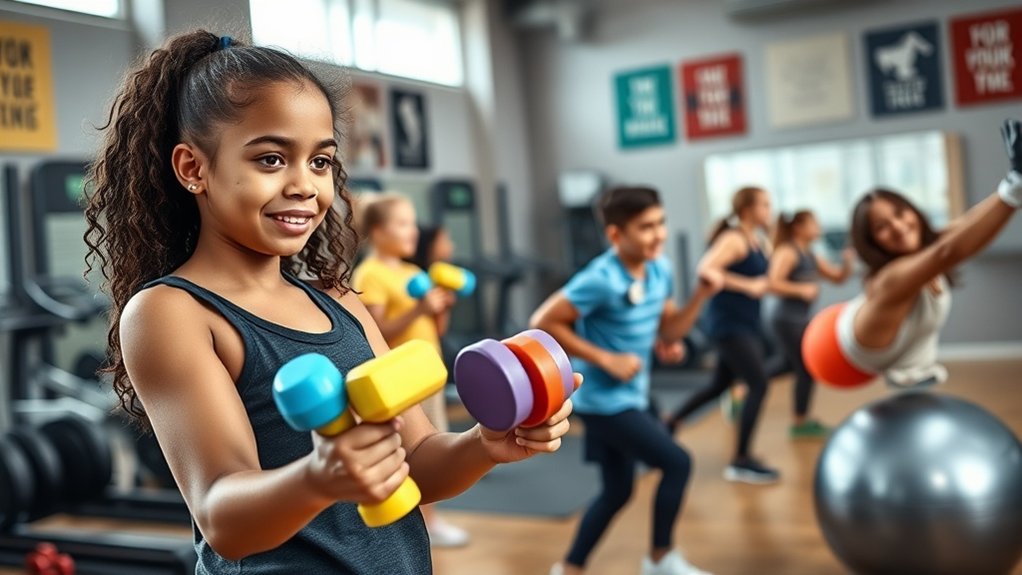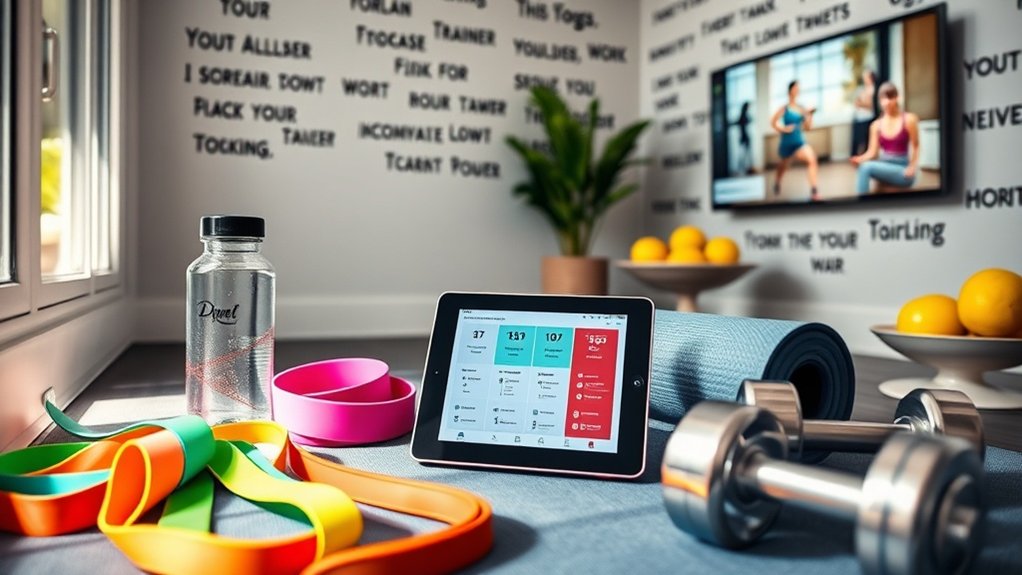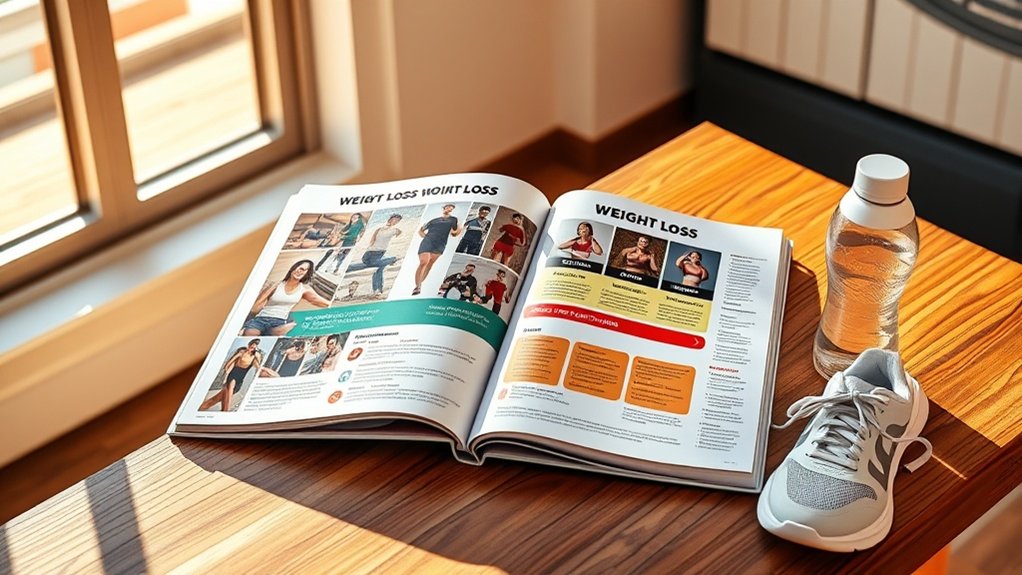For teens aged 13-19, you’ll want to prioritize proper form over heavy weights to protect developing growth plates and connective tissues. Start with bodyweight exercises before adding resistance, then increase loads by 5-10% only after mastering 12-15 reps comfortably. Aim for 1-3 weekly strength sessions combined with 60 minutes of daily physical activity, including aerobic exercise. Working with a qualified coach guarantees safe technique while building the foundation for lifelong fitness habits and injury prevention that’ll serve your teen well into adulthood.
Understanding Teen Growth and Development: Why Age-Appropriate Training Matters
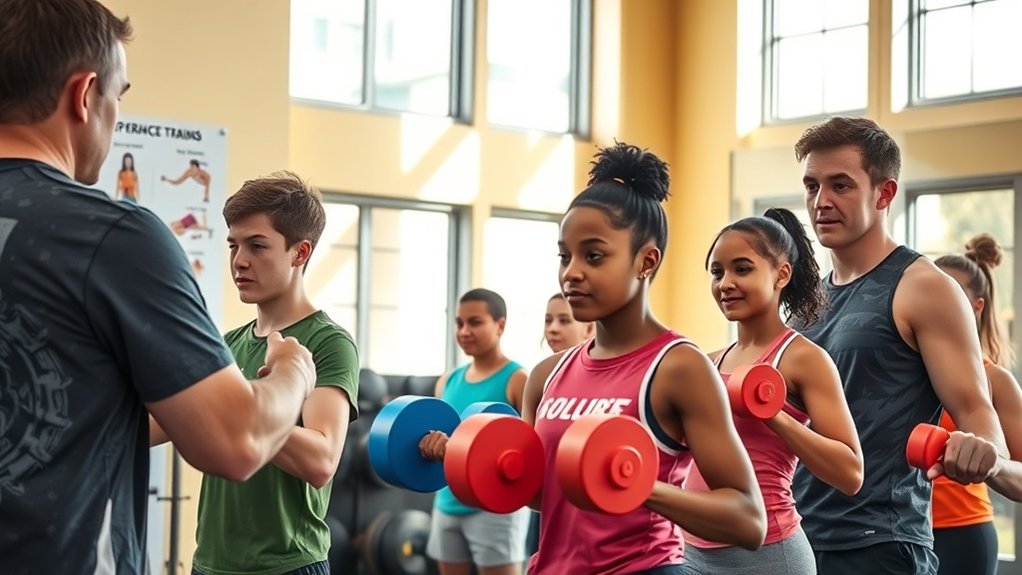
Because teenage bodies undergo rapid physiological changes between ages 13 and 19, you’ll need a workout plan that adapts to these developmental stages rather than mimicking adult training programs.
During growth spurts, your bones lengthen quickly, making bone density support through proper strength training essential. Age-appropriate fitness routines prioritize learning proper form over lifting heavy weights, protecting your developing musculoskeletal system from injuries that could impact you long-term.
Before puberty, focus on bodyweight exercises and technique mastery rather than muscle mass. As hormonal changes progress, you can gradually increase training intensity while maintaining safety standards.
The NHS recommends 60 minutes of daily physical activity, combining aerobic and strengthening exercises. This balanced approach builds healthy habits while respecting your body’s unique developmental timeline.
Debunking Strength Training Myths: Separating Facts From Fiction for Young Athletes
Misinformation about teen strength training spreads quickly, especially when parents worry they’ll accidentally harm their child’s growth plates or stunt their development. Research proves this myth incorrect—proper form and weight training actually promote healthy bone development in teenagers.
The real danger lies in following social media influencers who promote inappropriate workouts for teenage fitness needs.
You’ll find that strength training done correctly offers multiple benefits. It helps teens build strength, improves athletic performance, and supports mental health by boosting self-esteem and reducing anxiety.
The key isn’t avoiding weights—it’s emphasizing proper technique over heavy lifting.
Guidelines recommend 1-3 weekly sessions focusing on form. With qualified supervision, even children aged 7-8 can safely start.
This myth clarification reveals that maintaining healthy weight and fitness depends on doing things right, not avoiding them entirely.
Essential Safety Guidelines and Proper Form Techniques for Teenage Lifters
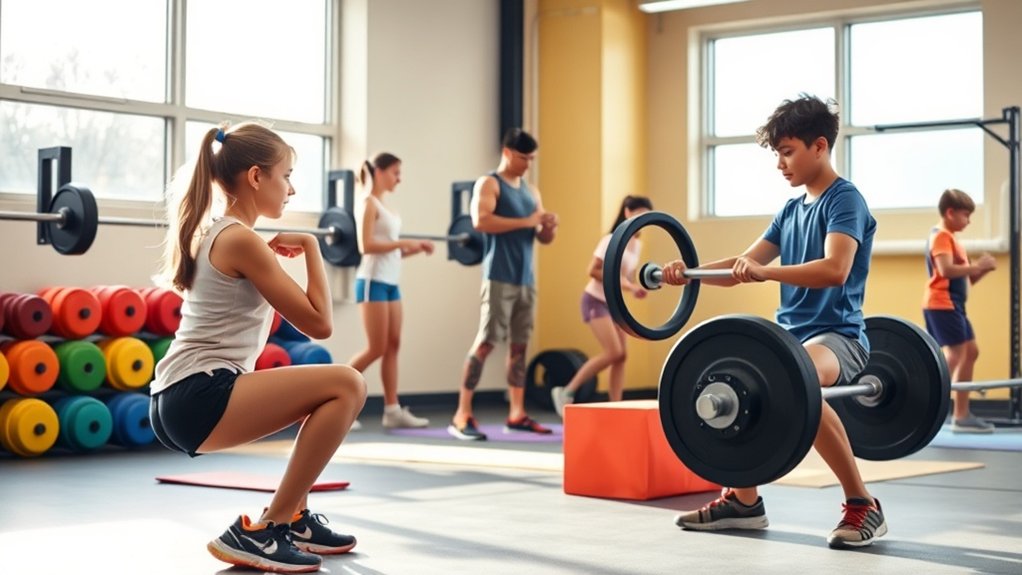
When teenage lifters master proper form from day one, they’ll build a foundation that protects their bodies throughout their fitness journey.
These safety guidelines guarantee teen lifters train effectively while minimizing injury risk.
Start with bodyweight exercises before introducing light weights. You’ll develop correct technique without the added stress of heavy resistance.
Once you’ve mastered form, apply progressive overload by gradually increasing weight—never sacrifice technique for heavier loads.
Always complete a 5-10 minute dynamic warm-up before lifting, followed by static stretches during your cooldown.
When advancing to heavier weights, use a spotter for protection and assistance.
Consider working with a qualified coach, especially as a beginner.
They’ll verify you’re executing movements correctly and safely, establishing proper habits that’ll serve you throughout your training career.
Progressive Loading Strategies: Building Strength Safely Through Adolescence
Progressive loading forms the backbone of safe strength development during your teenage years, but it requires a strategic approach that prioritizes your developing body’s needs.
You’ll need to understand how progressive overload works—the principle of gradually increasing demands on your muscles—while following age-specific guidelines that prevent injury during growth spurts.
Most importantly, you must always choose proper form over heavier weights, since maintaining technique guarantees long-term progress and protects your still-maturing joints and connective tissues.
Understanding Progressive Overload Principles
As your body develops during adolescence, building strength requires a strategic approach that protects growing bones and joints while maximizing gains. Progressive overload forms the foundation of effective strength training for teenagers, involving gradual increases in resistance to challenge your muscles safely. Start your routine with bodyweight exercises before advancing to light weights, guaranteeing you’ve mastered proper form throughout each movement.
| Progressive Overload Method | Application for Teens |
|---|---|
| Weight Adjustment | Increase load by 5-10% after completing 12-15 reps comfortably |
| Repetition Progression | Add 2-3 reps per set weekly |
| Exercise Variation | Progress from basic to complex movements |
| Volume Increase | Add sets gradually to target muscle groups |
| Rest Period Modification | Decrease rest time while maintaining form |
This systematic approach guarantees balanced development while preventing plateaus and injuries.
Age-Specific Weight Progression Guidelines
Building strength safely during your teenage years requires matching your training intensity to your physical maturity level.
If you’re 12-14, you’ll focus on mastering bodyweight exercises and proper form before adding resistance—typically limiting loads to 50% of your body weight. This foundation prepares you to build muscles safely through progressive loading.
As you reach 15-18, you can incorporate free weights, advancing to 70-85% of your one-rep max for compound movements.
Your age-specific approach should include 2-3 sets of 8-12 repetitions for strength-building exercises. Once you’re completing target reps comfortably, increase weight by 5-10%.
Always prioritize adequate recovery between sessions, and guarantee your physical maturity supports increased training intensity before progressing further.
Monitoring Form Over Load
Your technique matters more than the numbers on your weight plates. Monitoring form throughout strength training guarantees proper technique reduces injury risk while maximizing muscle engagement.
Focus on completing 8-12 repetitions across 1-3 sets with excellent form rather than attempting heavier loads prematurely.
Progressive loading works best when you’ve mastered movement patterns first. Add small weight increments—typically 5-10%—only after consistently demonstrating correct technique. This approach delivers safe strength gains without compromising your developing body.
Record your workouts or train under supervision to maintain accountability. Regular technique assessments help you identify compensatory movements before they become habits.
Incorporate varied exercises to promote balanced development across all muscle groups, which is essential during adolescence when your body undergoes significant physical changes.
Sport-Specific Training and Injury Prevention for Teen Athletes
When teen athletes commit to sport-specific training, they’re investing in both performance gains and long-term physical health.
Research shows sport-specific strength training can reduce the risk of injuries by up to 50% through targeted muscle development that protects growing bones and joints.
Vital injury prevention strategies for teen athletes:
- Implement proper warm-up routines tailored to your sport’s movement patterns
- Monitor training loads carefully to avoid overuse injuries in developing bodies
- Schedule adequate recovery periods between intense sessions
- Progress gradually with strength training exercises specific to your athletic demands
Your body’s still developing, making injury prevention vital.
Creating Sustainable Fitness Habits: Long-Term Success Beyond the Teenage Years

The fitness habits you establish now will shape your relationship with exercise for decades to come. Research shows that regular physical activity during your teenage years considerably increases the likelihood you’ll stay active as an adult.
Build muscle and mental resilience by mixing strength training with aerobic workout sessions—variety prevents burnout while creating a well-rounded foundation. Set achievable fitness goals and track your progress to fuel motivation and confidence.
Join fitness classes or team sports to find your support community; accountability and connection make staying consistent easier. Beyond physical benefits, you’ll experience improved mental health outcomes, including reduced anxiety and depression.
These habits aren’t just about today’s workout—they’re investments in lifelong wellness.
Frequently Asked Questions
Should a 14 Year Old Do Strength Training?
Yes, you should do strength training at 14, as it offers strength training benefits like improved teenage fitness and physical growth. Focus on proper form for injury prevention, maintain exercise variety, and seek nutrition advice for ideal workout motivation.
What Is the 3-3-3 Rule in Gym?
The 3-3-3 rule means you’ll perform three sets of three reps at 85-90% of your max weight. While it’s effective for strength gains, beginners shouldn’t start here—master proper technique first with lighter weights.
How Much Exercise and Strength Training Should a Teenager Do?
Ironically, while you’re glued to screens, you’ll need 60 minutes daily exercise plus strength training twice weekly for fitness goals. This exercise frequency guarantees strength training benefits, injury prevention, and mental health improvements through age-appropriate exercises meeting your nutritional needs.
What Is a Good Workout Plan for Teens?
You’ll need a balanced plan combining cardio and strength training 3-4 days weekly, aligning with your fitness goals. Focus on exercise variety, proper safety tips, nutrition advice, and recovery strategies while tracking progress through goal setting to boost teen motivation and strength benefits.

